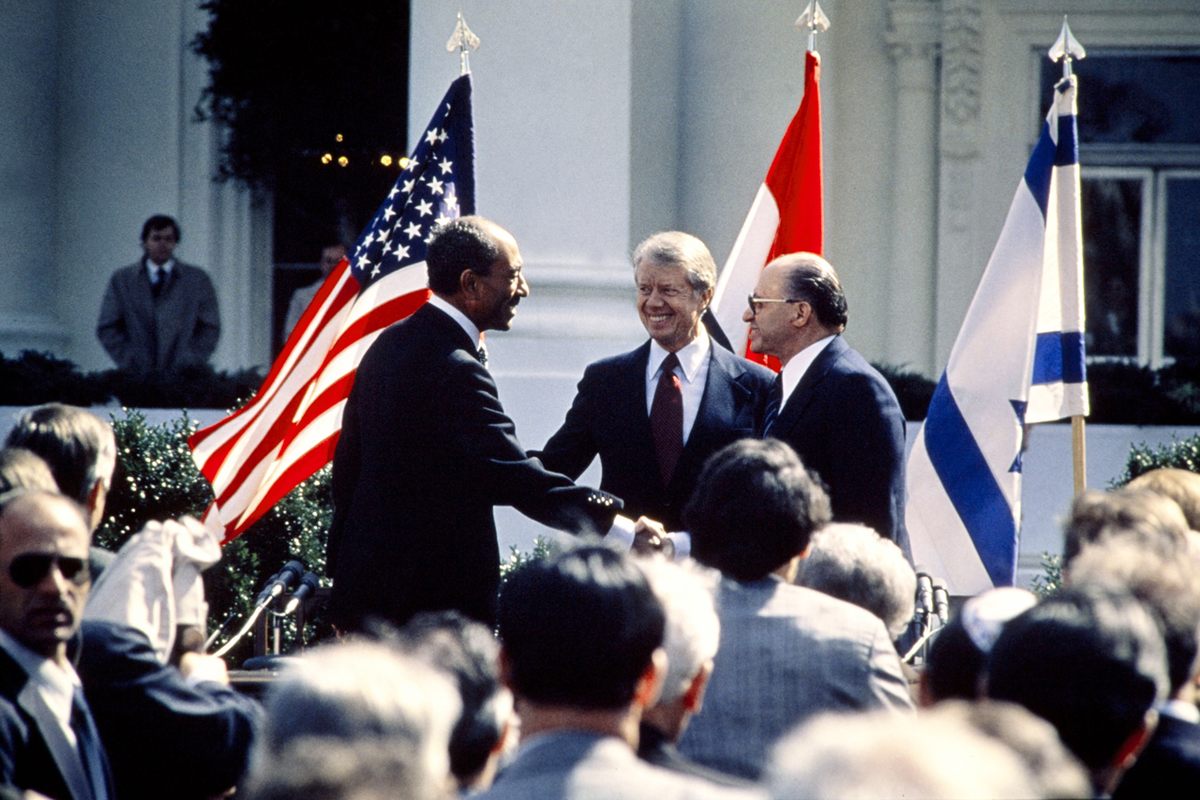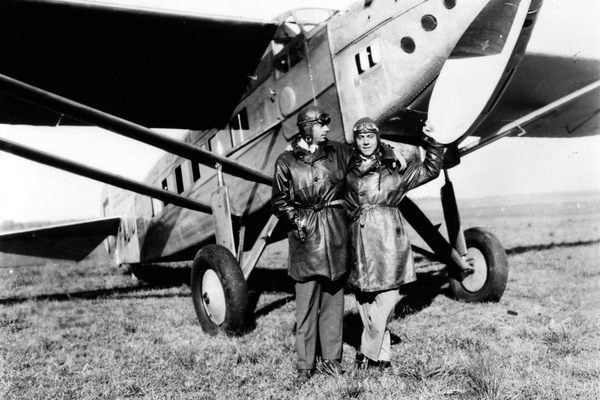
The Ghost Airline That Has Linked Cairo and Tel Aviv for Decades
Air Sinai is shrouded in mystery. But why?
In 2007, Michael Paley went to Cairo to visit his daughter, Naamah, a junior at the University of Michigan who was spending a semester in Egypt studying Arabic. He had a work trip in Israel scheduled for a few weeks later, so he asked one of the trip administrators to book him a ticket directly from Cairo to Tel Aviv. It’s a 50-minute flight on a clear day.
“I wasn’t nervous before about it,” he says, recalling the trip, “but when I got to the airport I got nervous because I couldn’t find the gate. It wasn’t posted on the screen, so I had to ask someone where to go, and then when I found the gate there was no sign that said this is Tel Aviv.”
Eventually, Paley was directed onto a bus that took him and the other passengers to a far corner of the tarmac, where a small white plane with no markings or logo was waiting. They boarded.
“The feeling you get is that you’re going somewhere illicit,” he says, adding that the oddity of the flight has stayed with him even years later. “You’re entering into an anonymous experience, and you’re clearly not in Milan, or New York.”
The unmarked plane belonged to Air Sinai, which only flies between Cairo and Tel Aviv. In 1979, Israel and Egypt signed a historic peace treaty, overseen by the United States, which inaugurated diplomatic relations between the two countries and made Egypt the first Arab nation to recognize the State of Israel. Air Sinai, founded in 1982, fulfills a term in the treaty that had to be implemented within three years of signing: the two countries must maintain active civilian aviation routes—meaning there always had to be a direct flight between Israel and Egypt.
It just didn’t have to be public.

“Virtually all of the Arab world boycotted Egypt after the treaty,” explains Ambassador Daniel Kurtzer, who oversaw the fulfillment of the treaty terms as the U.S. ambassador to Egypt from 1979 to 1982. He added that this reaction by neighboring countries, plus the general animosity towards Israel among Egyptian citizens, made Egypt reluctant to fly the Cairo-Tel Aviv route publicly on its national carrier, EgyptAir, which was a leading airline throughout the Arab world. “Part of Egypt’s calculation was that such a visible link poured vinegar on the situation,” he says.
That reluctance led to the creation of Air Sinai, which allowed Egypt to fulfill the terms of the treaty without directly implicating EgyptAir. Air Sinai used EgyptAir pilots, planes, and flight attendants, operating under a wet-lease agreement that effectively meant no difference between the two airlines, except on paper. Caution was still taken: The lack of any external logos on the planes afforded some privacy to the flight, and many have wondered if the Egyptian military keeps tabs on travelers between the two countries. Ambassador Kurtzer said he wouldn’t be surprised if the Egyptian military has some stake in the airline.
The reluctance also meant extreme privacy around Air Sinai’s existence. For most of its history, anybody looking online for tickets between Cairo and Tel Aviv would find a host of options for airlines offering indirect flights with stops in places like Amman, Jordan or Istanbul, Turkey. They might find a few references to a direct flight operated by an airline called Air Sinai, but any attempt to book it would end in a message to call a travel agent or contact the airline directly.

The problem with that advice was that Air Sinai had no website, no public schedule of flights, and no mechanism for online bookings. There was no number to call. Though the airline had technically been a subsidiary of EgyptAir since 2002, EgyptAir pretended there was no connection. The only way to book a ticket through Air Sinai, for those in the know, was to go through a full-service travel agency or email the company, having found their address through word of mouth. An employee would then ask for a scan of your passport and an international wire transfer to cover the cost of the ticket.
The airline only took cash, and sometimes only took U.S. dollars. For years, before Air Sinai accepted emails and wire transfers, prospective passengers would arrive at the Tel Aviv office with envelopes of cash and leave, as late as 2010, with an old-school yellow ticket that looked like a 1950s prop. More recently, passengers have been emailed their flight information. Credit cards were not an option—and still aren’t, when dealing directly with the airline. One recent passenger from the U.S., upon realizing she needed to cancel her flight, had to find a friend with an Israeli bank account who could accept the refund on her behalf. Many describe the flight booking experience as strangely intimate, reminiscent of how flying worked before the days of online transactions. A passenger flying in June 2019 recalls getting a cell phone call from the same woman he had corresponded with over email to book his flight. She called to let him know his flight would be rescheduled to the next day, as a group of South African pilgrims had booked up the entire plane on his chosen date.

Confused passengers have discovered some booking-system workarounds over the years: A couple from Atlanta, Georgia, who flew on Air Sinai in the summer of 2019, said they simply called EgyptAir from the U.S. and kept getting transferred until they found someone who was willing to take their credit card information and issue them tickets. Passengers flying as recently as 2013 have reported booking EgyptAir flights from locations in South Africa, like Cape Town or Johannesburg, and being able to select Tel Aviv as a final destination online, with a stopover in Cairo that transitions flyers to an Air Sinai flight. This was a particularly popular option while it lasted, as most flights to Israel from South Africa require long layovers. That option disappeared in 2014, when EgyptAir formally removed Israel from its flight map during the second Gaza war, and dropped all mention of the Tel Aviv location on its website. (Intriguingly, 2014 is also when Cairo International Airport and Ben Gurion International Airport in Tel Aviv began displaying the Air Sinai flight on their public check-in boards).
In February 2020, flyairsinai.com popped up. Suddenly, anybody had the option to book an Air Sinai flight. Passengers could select any of the daily flights without needing to send emails back and forth to someone in the Air Sinai office. They could even use credit cards.
While one could see this as a sign of increased warmth between Israel and Egypt, the transparency isn’t quite there. The website describes itself as a third-party travel agency only. There is no listed contact information, nor any social media presence. The site and its web developer are based in the United Kingdom. When asked directly about flyairsinai.com, an Air Sinai employee responsible for booking tickets denied having any connection to the site, though she added an emoji smiley face to the end of her email. She then stopped responding to any requests for comments.
By all accounts, the planes remain unmarked.

Over the decades, the flight route between Egypt and Israel has reflected political developments. After its inception in 1982, Air Sinai took over the Cairo-Tel Aviv route from Nefertiti Airlines. An Egyptian entrepreneur, Elhamy Elzayat, founded Nefertiti to capitalize on the new tourism opportunity by operating flights between the two countries from 1980-1982. Elzayat also ran a fleet of buses between the two countries, which remained a popular mode of travel for Israelis visiting Egypt until 2012, when security concerns forced buses to cancel their services. The majority of air travelers in the early decades were Israeli tourists eager to pour across the border and visit one of the few countries they could now travel to by land, amid a sea of neighbors still technically at war with them. The flight was also popular with international Christian pilgrims visiting holy sites in the region, and businessmen traveling in the Middle East. Israel’s national carrier El Al, which has since gone private, flew a regular flight for years, though for added discretion would only schedule flights in the dead of night, between the hours of 1 a.m. and 6 a.m.. El Al ceased its flights in 2012, after concerns over the Arab Spring basically halted Israeli tourism to Egypt entirely, leaving El Al flying virtually empty planes between the two capital cities, at great security and operational cost.
At that point, Air Sinai remained the only airline in fulfillment of the 1979 terms of normalized relations between the countries, though the impact was minimal on the Egyptian side, as Egyptian tourism to Israel has always been muted. While the Egyptian government often touts the lack of intrigue in visiting Israel as the reason, the truth is that there remains strong local resistance against visiting Israel. Travel is also much more difficult for Egyptians, who must obtain an exit visa from the Egyptian government to even visit Israel, as well as a visa from the Israeli embassy, which currently has no personnel on the ground in Egypt. Egyptian citizens under a certain age, which for men has ranged from 60 to 45, and for women generally been under 35, require additional clearance. (Younger people are considered more of an unknown, and thus more of a potential political threat.) Reportedly, applications have resulted in aggressive questioning by Egyptian forces about the reasons for such a visit, causing political tension that most Egyptians admit is not quite worth it. The Israeli embassy currently notes on its website that any Egyptian man under the age of 50, and Egyptian woman under the age of 35, is unlikely to be approved for a visa quickly.

The one significant shift has been in tourism from Coptic Christians: In 2015, Pope Tawadros II, the Pope of the Coptic Church, reversed a ban on visiting Israel which had been issued by his predecessor in the wake of the 1979 peace treaty. Since then, Coptic Christians have visited the religious sites in Israel in ever-increasing numbers. Though Israeli tourism has decreased, it still exists, with Israelis often going incognito about their identity to prevent negative reactions. One tour group of Israelis, which visited Philae Temple in Aswan, one of Egypt’s most southern cities, as part of an extended trip in 2016, said they feel comfortable speaking loudly in Hebrew, though most Egyptians assume they are Greek or Italian, and they don’t correct them.
Today, Air Sinai continues to serve businesspeople, Coptic travelers, Christian pilgrims, and tourists traveling throughout the Middle East. The new online presence suggests the airline is interested in coming out of hiding to attract more customers, and perhaps less hindered by security concerns. (Though, again, Air Sinai did not respond to requests for comment for this story). While Israeli tourism has not regained the numbers seen in the 1980s and 1990s, the continued existence of Air Sinai serves as a reminder that connections between these two countries remain both possible and active. A time may soon come when Israelis and Egyptians can visit one another a bit more publicly, or at least a bit more easily.







Follow us on Twitter to get the latest on the world's hidden wonders.
Like us on Facebook to get the latest on the world's hidden wonders.
Follow us on Twitter Like us on Facebook